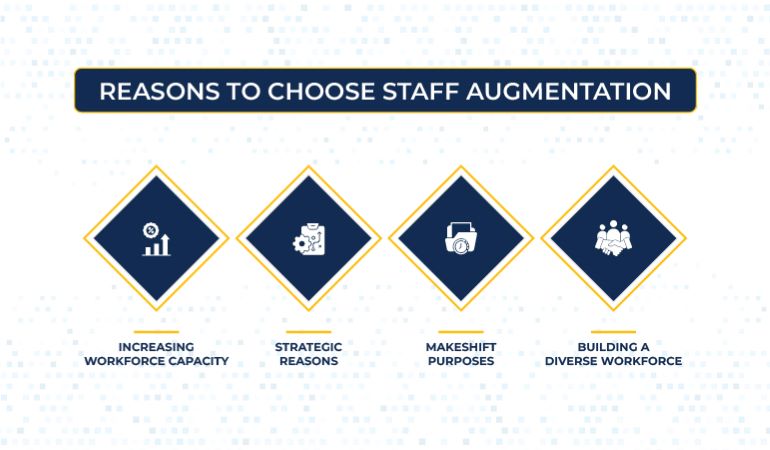The concept of contingent workers has become increasingly popular in today’s organizations. Contingent workers do not form part of an organization’s traditional workforce. Instead, they work on a temporary basis as independent contractors, freelancers, or consultants.
It isn’t something new; companies have long sought to hire contingent workers to fill vacant roles, either temporarily or permanently. The reasons can be many: illness, vacation, death of an existing employee(s), new projects, etc.
With the rise of the IT industry and the disruption it is causing across sectors, the concept of contingent worker vs staff augmentation contingent workers has really taken off.
Businesses seek to enhance their workforce competencies by means of such practices. One such practice is staff augmentation services.
What is Staff Augmentation?
It is the process of hiring outside resources through a third-party vendor to supplement your company’s existing workforce capacity. Such hiring is mainly on a temporary basis but may also be permanent.
In other words, staff and resource augmentation is a flexible hiring process that attracts talent from around the world. As with all hiring models, the aim is to help the business achieve its short-term and long-term goals.
How Does Staff Augmentation Works?
It is primarily an outsourcing model that works by contracting a service provider to fulfill the outsourcing company’s staffing needs.
Suppose “Company A” HR augmentation is looking to hire a marketing consultant to execute the launch of a new product. “Company A” gets in touch with “Company X”, which happens to be a staff augmentation service provider, to hire the marketing consultant.

“Company X” will then provide “Company A” with one of its own resources to execute the launch of the product remotely. In case “Company X” does not have the required resources, it will hire one and then provide the same to “Company A” remotely.
The most important thing to understand about resource augmentation is that the resource primarily works remotely for the outsourcing company. The resource is almost always located at the service provider’s site but works dedicatedly for the IT outsourcing company. The provision of necessary infrastructure to the resource is also the service provider’s responsibility.
However, sometimes, an outsourcing company can also go for on-site staff or employee augmentation. We shall explain this later when the article touches upon the types of external resourcing strategies.
Alternatively, “Company A” can outsource the entire launch project to “Company X” for execution. But this is not resource augmentation; it is project outsourcing. One must not confuse the two.
Top Reasons to Choose Staff Augmentation
Why do companies opt for external resourcing when they can hire resources themselves?
The reasons are multiple. Companies leverage resource augmentation for the following reasons:
Increasing workforce capacity – Increasing the capacity of the workforce is a key reason for external resourcing. The need to increase capacity can be due to seasonal demand spikes, new markets, or new projects. Any business activity that requires more workers can leverage the resource augmentation model to meet its needs.
Building a diverse workforce – Some companies undertake a resource augmentation drive to bring more diversity – both in terms of skills and culture – to the workplace. Although the augmented staff works remotely, it remains in close contact with the relevant team members. This allows for a transfer of both knowledge and other skills.
Makeshift purposes – Companies also augment their staff as a makeshift arrangement. This is usually when the company has long-term plans to hire a new on-site team. While the hiring process takes place, resource augmentation fills in the void to keep the work flowing. The company can let go of remote employees hired through outsourcing once the hiring process is completed and a new team is in place.
Strategic reasons – A company can build its entire workforce based on an outsourced hiring model. The aim of doing so would be to utilize the flexibility of such a workforce, thereby gaining a competitive edge.

Benefits of Resource Augmentation
There are many benefits of resource augmentation. We have listed some of the significant benefits of outsourcing for you.
- A talented and competent augmented staff can quickly comprehend and deliver what is required of it.
- Outsourcing saves time and money since it circumvents the traditional hiring process.
- It allows the outsourcing company to seek and hire a specific skillset based on the requirements of a new project.
- External resourcing can help companies ride out an economic downturn by keeping their workforce flexible.
- Resource augmentation can provide workers on a need-based basis, as is the case with companies that operate seasonally. This makes it a very flexible hiring model.
- It is the service provider’s responsibility to hire the right resource for the outsourcing company. Failure to do so impacts the service provider more than the outsourcing company.
- The outsourcing company controls the hired resource through close communication and performance appraisal. It keeps a close eye on the productivity levels of the resource and can choose to let go of it if it doesn’t perform.
Challenges of Staff Augmentation
External resourcing is not all roses. There are a few challenges as well. Some of these are:
- It may represent higher costs because the service providers add a margin to the labor cost. They also charge for overheads, not separately but as part of the labor cost.
- The outsourcing company may eventually offset the cost benefits of external resourcing if it uses the model long-term.
- Continued reliance on externally augmenting your work can create a poor management cycle due to ill planning regarding resource consumption and access. This can cause a staff or job creep, a situation where employees are typically expected to do more than their job requires.
- Service providers can become embedded in the company and turn into permanent high-cost staff.
- Miscommunication between team members can affect the project.
Types of Staff Augmentation Strategies
On-site – This is when companies hire a third-party vendor to supplement their full-time workforce by sending the resource(s) to their office. Under this strategy, the hired resource(s) will work for a specific period on the premises of the outsourcing company. This strategy is mainly employed for IT staff augmentation, where technical resources might be required on-site.
Onshore – It refers to hiring a resource based in the same country as the outsourcing company, but not necessarily in the same town or city. It allows the company and the resource to work in the same time zone.
Nearshore – As the name suggests, this approach entails hiring a resource from a nearby country. The time difference between the resource’s country and the outsourcing company’s country is no more than a few hours. So, if a company in the U.S. wants to employ this strategy, the resource would most likely be situated in Mexico or Canada. Or anywhere in Central or South America.
Offshore – This approach involves hiring a resource that is nowhere near the client company’s country. In fact, there is significant variation in the time zones of both countries. Companies use this strategy to save on labor costs. An apt example of offshore IT staff augmentation is the use of resources from developing countries like India and Pakistan.
Why is Staff Augmentation Popular in the IT Industry?
The ease with which IT staff augmentation offers the hiring process makes it so popular nowadays, especially given the massive size of the software market. It is reported that by 2025, this market’s revenue will be nearly $1,493 billion (11% CAGR). Growth at such rates would be impossible without access to a vast pool of software specialists.
That can be possible only with resource augmentation, which aids in distributing the IT workforce across businesses.
Furthermore, the flexibility of staff augmentation fits perfectly with the rising hiring demands of today’s IT companies. In-house team hiring involves multiple steps, including screening candidates and conducting background checks, as well as payroll decisions and registration processes. As such, it is lengthy, resource-consuming, and ultimately unsuitable if you want to quickly onboard talent for urgent projects in the pipeline.
Moreover, releasing such employees is also inconvenient, reducing your in-house employee value, mainly when you require new employees for a limited time.
Quick staff augmentation is the other advantage of hiring a third-party outsourcing vendor. Your outsourcing vendor takes care of all the hiring steps and formalities. They hire the right persons who are competent developers with the experience you require for the project. All you or your company’s executive needs to do is interview the selected individuals and onboard the right candidates.
This makes your company agile to succeed when aligned with the project’s timeline and delivery, which averts revenue loss and a slow market launch.
How to Make the Most out of Your Staff Augmentation
Staff augmentation top tricks have lasting effects on a company’s performance and future, so it is important to devise a strategy carefully.
We will highlight the factors you need to consider before making a decision to hire external resources. After all, making the right strategic decisions will play a vital role in making your staff augmentation a success.

Let’s look at these factors.
Identify your requirements – A detailed analysis of your company’s requirements is essential for making the right choices. Undertake a thorough talent audit of your existing workforce, identify the skill gaps, and then hire accordingly. Also, you may want to analyze the skill set of your workforce and compare it with the skill set a new project would require.
Choose the right vendor – It is crucial that you properly evaluate potential vendors for resource augmentation. It must be remembered that each vendor has its own selection strategy and that no two vendors are alike. It would be best if you also looked at the vendor’s culture and whether it aligns with your company’s culture. The significance of finding the right service provider cannot be overemphasized.
Ensure team synchronization – It is very important that your company looks after remote resources. Building a good relationship between all team members should be the priority. Everyone, irrespective of location, should feel like they are part of the same team. Synchronization is key to staff augmentation’s success.
Leverage collaboration tools and technologies – Using team collaboration tools like SharePoint, Slack, Zoom, and Trello can significantly improve the coordination and communication between your team members. Such tools should be utilized throughout the project’s life to avoid miscommunication. The absence of robust communication can seriously impact your bottom line.
Final Thoughts
The resource augmentation industry is rapidly growing. According to research, the outsourcing industry is expected to be worth $531 billion by the end of 2022. Staff augmentation is part of the outsourcing industry.
The COVID-19 pandemic has tremendously boosted the staff augmentation industry, particularly the IT staff augmentation industry. The rise of new technologies like AI and Machine Learning is pushing businesses to undergo digital transformation.
The demand for IT resources is not going to reduce any time soon. It will only increase, and that too exponentially. So would the IT staff augmentation industry.
If you wish to know more about staff augmentation, please feel free to contact us at [email protected]

